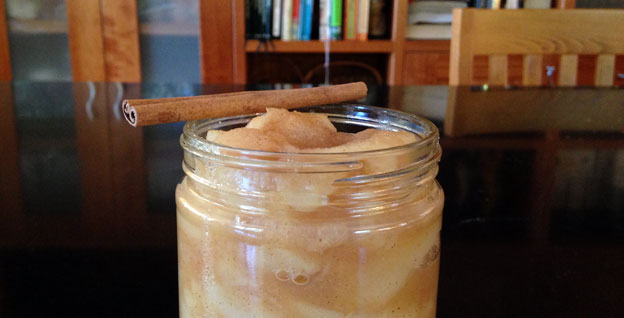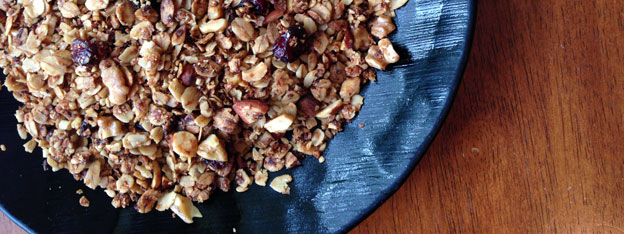As I flipped pancakes on a recent Saturday morning, I was thinking about how much more baking I’ve been doing recently (skip the chatter, and go straight to the recipe). For instance, besides the pancakes, the day before, I made whole wheat walnut-raisin bread, and that night, the DH was going to be making pizzas, one with pepperoni and one with sausage and green bell peppers. Yeah, yeah, I know, pancakes aren’t baked; the actual connection is the main ingredient, flour (but I do keep the pancakes warm in the oven, wink), and when I think flour, I think baking.
A couple of different things led to this state of affairs. It all started last summer, when a friend shared a lemon muffin with me that she made with King Arthur White Whole Wheat Flour (thanks, Michele!). We could’ve been in an ad, all exclamatory remarks: “You’ve gotta try this!” “This is made with whole wheat flour? No way! It’s so light, and the color is like regular flour!” Then she gave me a bag with a couple of cups in it, and I started playing with it. I began substituting the white whole wheat flour in muffins, cookies, and brownies, starting with just a quarter of what the recipe called for, then a third, and now, depending on the recipe, half or all the flour. Everyone—the family, my adult friends, the kids’ friends—continued to ask for my baked goodies (better than complements, I think), so it just encouraged me to try it in more recipes.
Eventually, I ran through the recipes I usually make and that I wanted to substitute in white whole wheat flour, but I was on a roll. And when my friend Julie asked me what she could do with her new stand-mixer besides bake sweet treats, I thought of bread. Now, I used to bake bread here and there—mostly things like challah and standard 1½ lb. loaves for sandwiches—before I had the kids, but bread making mostly fell by the wayside as I focused on my two bundles of joy. The big exception is pizza, which the DH or I still make from scratch, including the dough. But I love (who doesn’t?) that heady, yeasty perfume and slight crunch of cutting open a fresh-baked loaf. I’m lucky that there are many great bakeries in the Bay Area, and I occasionally buy beautiful breads from Semifreddi’s, my favorite local bakery. Taking a page from my book Twice As Nice, I’ve taken to stashing a few of their wheat panini in the freezer to use on the fly. But the local bakeries don’t stock a large variety of whole wheat loaves, so I started keeping an eye out for recipes for whole wheat bread, especially bread which I can then freeze and then later, defrost just as much as I need. Goody! More baking! I’ve continued experimenting with both white whole wheat and regular whole wheat flours, and I’m sure that I will be sharing some recipes in the future.
Here’s what I learned: substituting some or all the the regular white unbleached flour with King Arthur White Whole Wheat in everyday recipes works well. If it’s not at your local grocery store, you can get it directly from King Arthur’s website or from Amazon. Since the nutrition profile of white whole wheat flour is the same as regular whole wheat, it’s a great way to bump up the healthfulness and heartiness of everyday baking (including pancakes and waffles!). The white whole wheat flour, milled from white spring wheat rather than traditional red wheat (according to the King Arthur website), is heavier than regular white flour, so it’s very important to use proper measuring technique to avoid a dense or dry end result: loosen up the flour by stirring it around inside its container (I suppose sifting the white whole wheat flour before measuring it would be the foodie thing to do, but frankly, I’m too lazy for everyday baking), then scoop the flour into your measuring cup. Finally, use a butter knife to scrape off the excess—never tamp it down! For every ½ cup of regular flour, substitute ½ cup minus 1 tablespoon white whole wheat. The white whole wheat does add a “tan” and a subtle nutty flavor to the dishes, which I think actually makes things like pancakes taste better. But I wouldn’t substitute it in cakes, pie or tart crusts, and other delicate baked goods; after all, treats are treats are treats. Leave ‘em alone, I say. There’s plenty of other ways to make our everyday cooking healthier; an easy way is to start with these pancakes with ½ cup, 1 cup, or all white whole wheat flour!
Recipe: Pancakes
This is my pancake recipe; I’ve used it for years, but now I usually make it with 1 cup white whole wheat flour. I even make it with all white whole wheat, which the DD prefers. It’s a good recipe to experiment with, because you can easily substitute ½ cup, 1 cup or all the regular flour for white whole wheat. Just remember to use proper measuring technique, and subtract 1 tablespoon for every ½ cup!
Makes about 20 pancakes
Ingredients
- 1½ cups flour
- 1½ tablespoons sugar
- ¾ teaspoon baking soda
- ½ teaspoon baking powder
- ¾ teaspoon cinnamon
- ¼ teaspoon salt
- 1 cup lowfat buttermilk
- ½ cup skim or lowfat milk
- 3 large eggs
- 1½ tablespoon canola oil, plus more for greasing pans
- 1½ teaspoon vanilla
Preparation
Heat a serving plate in 150°F oven. Lightly grease a cast-iron double burner griddle pan with a little vegetable oil, and heat over low flame. If not using a cast-iron pan, after the pancake batter is ready, heat your preferred pan, greased a little vegetable oil, over medium-low heat until hot but not smoking.
Place all the dry ingredients into a medium bowl and whisk together; make a well in the center of the dry ingredients. Add the wet ingredients to the dry ingredients and whisk just until smooth. Let the batter rest for a minute.
Fill a ¼-cup measuring cup about ¾ full for each pancake (about 3 tablespoons batter). Cook the first side until bubbles are forming on top, the edges begin to set, and the bottom is golden brown, about 2 minutes. Flip and cook another minute. Grease the pan again as needed. Move the cooked pancakes onto the serving plate, keeping them warm in the oven until ready to serve.
Serve with your favorite toppings.



